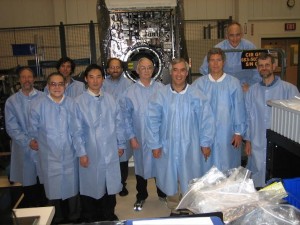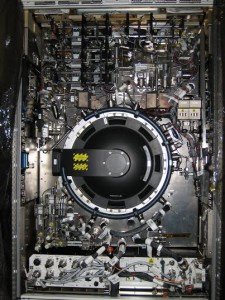
For all its Hollywood glamour, Gravity got one thing pretty much right: how fire acts in space. According to Yale Professor of Mechanical Engineering Mitchell Smooke, the floating fireballs that Sandra Bullock dodged are accurate portrayals of the rounded, longer-lasting properties of flames in zero gravity. Rather than using them to thrill audiences, however, Smooke and his colleagues seek to understand how these fireballs work and to apply this knowledge of combustion to solve issues both in space and closer to home.
Smooke is a computationalist, solving fluid mechanical and thermochemical equations for the many chemical species that make up a combustion process. To check the validity of his calculations, Smooke collaborates with experimentalists who record various characteristics of the real-life combustion process. If the computational model does not agree with the experimental results, Smooke tries to understand the physics and chemistry of the system to obtain a better fit.
Although on-the-ground methods have been useful in elucidating some characteristics of soot formation, gravity is a significant confounding factor. “Compared to in 1 g, there is no convection or buoyancy in microgravity, and so flames are shorter and rounder,” said Smooke. “Thus, the residence time of particles in the flame is much longer and you have more time to try and understand what’s happening there.”
In addition to exhibiting this helpful velocity decrease, flames in microgravity produce almost an order of magnitude more soot for a given flow rate, yielding more particles that can be analyzed. Further, the elimination of gravity makes computational modeling simpler.
Smooke and his experimental colleague, Professor Marshall Long, have been utilizing microgravity facilities such as drop towers and planes flying parabolic trajectories (aka “the vomit comet”). However, these methods of have drawbacks. The drop tower yields only 2-5 seconds of microgravity time, and the plane only twenty per parabola. Even in the plane, a gravity force of 10-2 g still exists – far from Smooke and Long’s ideal of 0 g.
But in 2009, they received a game-changing offer. NASA was planning to send an experimental facility called the Combustion Integrated Rack (CIR) to the International Space Station, and they had extended an offer to Smooke and Long’s group to perform experiments using it. “NASA put together a group of five similar projects with good track records of results and offered us the opportunity to use the space station,” said Smooke. “It was a wonderful opportunity to work in truly zero gravity.”
This group of projects, collectively called the Advanced Combustion via Microgravity Experiments (ACME), consists of scientists from Princeton, Rutgers, Wash U in St. Louis, U of Maryland, U of Hawaii, NASA Glenn and UC Irvine in addition to Yale. ACME is one of four groups of projects that NASA astronauts will conduct from 2014 to 2022. The ACME projects are slated to happen from 2017-2019.

The Combustion Integrated Rack, which was sent to the International Space Station in 2009 to allow astronauts to perform combustion experiments in space. Image courtesy of Dr. Mitchell Smooke.
This may seem like a long delay between project conception and completion, but Smooke notes that there are many administrative hurdles to performing an experiment in the International Space Station. “Because so much soot is produced by combustion in space, due to safety issues, engineering designs have to be done very carefully,” he said. “NASA has a very detailed approval and time-budgeting process.”
Nevertheless, Smooke doesn’t mind the wait, considering the tremendous potential of the results that he and Long could obtain from this study. A highly accurate model of soot formation obtained from Smooke’s mathematical models that matched the space station combustion data could revolutionize our understanding of soot formation. This understanding could help us design optimal fire safety protocols in space, as well as discover how to minimize pollutant soot emissions back on Earth. Smooke notes that even today in America, half of our energy for electricity comes from the burning of coal.
Smooke also greatly anticipates the ACME results because so far, his mathematical models have not fit the data from combustion done in the “vomit comet” as well as he would have liked. He hopes that eliminating the variable of gravity will help with both model fit and with the ease of understanding the weaknesses of the model.
However, Smooke emphasizes the value of not having his models be correct the first time around. “If the data matches our theoretical calculations, have we really learned anything new?” he said. “It the computational data doesn’t match the experiments, we work on the model and try to understand what processes improve the consensus. This is far more satisfying, and we learn more – we truly advance understanding in the field.”
